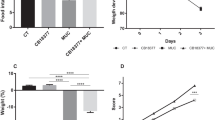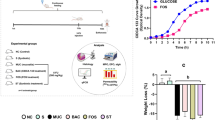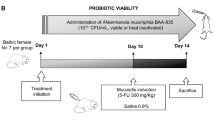Abstract
To investigate the efficiency of Saccharomyces boulardii on irinotecan-induced mucosal damage and diarrhea in rats, fifty rats were randomized into three groups with 20 rats in two study groups and 10 rats in the control group. Control group did not receive any treatment. Irinotecan (60 mg/kg) alone was administered intravenously once a day for four consecutive days to the rats of Group A. Throughout the experiment, Group B rats were additionally given Saccharomyces boulardii (800 mg/kg) for 3 days before administration of irinotecan and 7 days throughout the experiment. Delayed diarrhea was more severe in Group A than Group B (P = 0.009). The weight loss was 34.7 ± 3.8 mg for Group A, while it was 17.4 ± 1.7 mg for Group B (P < 0.001). Findings of mucositis most clearly appeared in the jejunum. Regarding edema (P = 0.003), leukocyte migration (P = 0.038), and inflammation (P = 0.006) significant recovery was detected in the mucosa of rats receiving Saccharomyces boulardii. Villous thickness was significantly greater in Group A than Group B (P < 0.001). The results indicate that Saccharomyces boulardii provided significant improvement in irinotecan-induced diarrhea and mucositis.





Similar content being viewed by others
References
Tanizawa A, Fujimori A, Fujimori Y, Pommier Y. Comparison of topoisomerase I inhibition, DNA damage, and cytotoxicity of camptothecin derivatives presently in clinical trials. J Natl Cancer Inst (Bethesda). 1994;86:836–42. doi:10.1093/jnci/86.11.836.
Douillard JY, et al. Irinotecan combined with fluorouracil compared with fluorouracil alone as first-line treatment for colorectal cancer: a multicenter randomized trial. Lancet. 2000;355:1041–7. doi:10.1016/S0140-6736(00)02034-1.
Park SH, et al. Randomized phase II study of irinotecan, leucovorin and 5-fluorouracil (ILF) versus cisplatin plus ILF (PILF) combination chemotherapy for advanced gastric cancer. Ann Oncol. 2008;19:729–33. doi:10.1093/annonc/mdm502.
Hanna N, et al. Randomized phase III trial comparing irinotecan/cisplatin with etoposide/cisplatin in patients with previously untreated extensive-stage disease small-cell lung cancer. J Clin Oncol. 2006;24:2038–43. doi:10.1200/JCO.2005.04.8595.
Muggia FM, Blessing JA, McGehee R, Monk BJ. Cisplatin and irinotecan in squamous cell carcinoma of the cervix: a phase II study of the Gynecologic Oncology Group. Gynecol Oncol. 2004;94:483–7. doi:10.1016/j.ygyno.2004.05.018.
Ribrag V, et al. Phase II trial of irinotecan (CPT-11) in relapsed or refractory non-Hodgkin’s lymphomas. Leuk Lymphoma. 2003;44:1529–33. doi:10.1080/1042819031000099643.
Stringer AM, et al. Chemotherapy-induced mucositis: the role of gastrointestinal microflora and mucins in the luminal environment. J Support Oncol. 2007;5:259–67.
Gibson RJ, Bowen JM, Inglis MR, Cummins AG, Keefe DM. Irinotecan causes severe small intestinal damage, as well as colonic damage, in the rat with implanted breast cancer. J Gastroenterol Hepatol. 2003;18:1095–100. doi:10.1046/j.1440-1746.2003.03136.x.
Buts JP. Twenty-five years of research on Saccharomyces boulardii trophic effects: updates and perspectives. Dig Dis Sci. 2008 (in press).
Surawicz CM, et al. Prevention of antibiotic associated diarrhoea by Saccharomyces boulardii: a prospective study. Gastroenterology. 1989;96:981–8.
McFarland LV, et al. Prevention of ß–lactam associated diarrhoea by Saccharomyces boulardii compared with placebo. Am J Gastroenterol. 1995;90:439–48.
McFarland LV, et al. A randomized placebo-controlled trial of Saccharomyces boulardii in combination with standard antibiotics for Clostridium difficile disease. JAMA. 1994;271:1913–8. doi:10.1001/jama.271.24.1913.
Surawicz CM, et al. The search for a better treatment for Clostridium difficile disease: use of high-dose vancomycin combined with Saccharomyces boulardii. Clin Infect Dis. 2000;31:1012–7. doi:10.1086/318130.
Buts JP, Corthier G, Delm’ee M. Saccharomyces boulardii for Clostridium difficile-associated enterocolopathies in infants. J Pediatr Gastroenterol Nutr. 1993;16:1497–504. doi:10.1097/00005176-199305000-00013.
Höchter W, Chase D, Hegenhoff G. Saccharomyces boulardii in treatment of acute adult diarrhoea efficacy and tolerance of treatment. Münch Med Wochenschr. 1990;132:188–92.
Kollaritsch H, Holst H, Grobara P, Wiedermann G. Prevention of traveler’s diarrhea with Saccharomyces boulardii. Results of a placebo controlled double-blind study. Forstchr Med. 1993;111:152–6.
Bleichner G, Bléhaut H, Mentec H, Moyse D. Sacchromyces boulardii prevents diarrhoea in critically ill tube-fed patients. A multicenter, randomized, double-blind-placebo-controlled trial. Intensive Care Med. 1997;23:517–23. doi:10.1007/s001340050367.
Saint-Marc T, Bl’ehaut H, Musial C, Touraine JL. Efficacit’e de Saccharomyces boulardii dans le traitement des diarrh’ees du SIDA. Am Med Int. 1991;142:64–5.
Guslandi M, Mezzi G, Sorghi M, Testoni PA. Saccharomyces boulardii in maintenance treatment of Crohn’s disease. Dig Dis Sci. 2000;45:1462–4. doi:10.1023/A:1005588911207.
Guslandi M, Giollo P, Testoni PA. A pilot trial of Saccharomyces boulardii in ulcerative colitis. Eur J Gastroenterol Hepatol. 2003;15:697–8. doi:10.1097/00042737-200306000-00017.
Pothoulakis C, et al. Saccharomyces boulardii inhibits Clostridium difficile toxin. A binding and enterotoxicity in rat ileum. Gastroenterology. 1993;104:1108–15.
Czerucka D, Roux I, Rampal P. Saccharomyces boulardii inhibits secretagogue-mediated adenosine 3′,5′-cyclic monophosphate induction in intestinal cells. Gastroenterology. 1994;106:65–72.
Czerucka D, Rampal P. Effect of Saccharomyces boulardii on cAMP- and Ca2+-dependent Cl-secretion in T84 cells. Dig Dis Sci. 1994;44:2359–68. doi:10.1023/A:1026689628136.
Czerucka D, Dahan S, Mograbi B, Rossi B, Rampal P. Saccharomyces boulardii preserves the barrier function and modulates the transduction pathway induced in enteropathogenic Escherichia coli infected T84 cells. Infect Immun. 2000;68:5998–6004. doi:10.1128/IAI.68.10.5998-6004.2000.
Dahan S, et al. Saccharomyces boulardii interferes with enterohemorrhagic Escherichia coli induced signalling pathways in T84 cells. Infect Immun. 2003;71:766–73. doi:10.1128/IAI.71.2.766-773.2003.
Dalmasso G, et al. Saccharomyces boulardii prevents TNFa-induced apoptosis in EHEC-infected T84 cells. Res Microbiol. 2006;157:456–66. doi:10.1016/j.resmic.2005.11.007.
Qamar A, et al. Saccharomyces boulardii stimulates intestinal immunoglobulin. A immune response to Clostridium difficile toxin A in mice. Infect Immun. 2001;69:2762–5. doi:10.1128/IAI.69.4.2762-2765.2001.
Powrie F, Leach MW, Mauze S, Caddle LB, Coffman RL. Phenotypically distinct subsets of CD4+ T cells induce or protect from chronic intestinal inflammation in CB-17 scid mice. Int Immunol. 1993;5:1461–71. doi:10.1093/intimm/5.11.1461.
Lee SK, Kim YW, Chi SG, Joo YS, Kim HJ. The effect of Saccharomyces boulardii on human colon cells and inflammation in rats with trinitrobenzene sulfonic acid-induced colitis. Dig Dis Sci. 2008 (in press).
Sougioultzis S, et al. Saccharomyces boulardii produces a soluble anti-inflammatory factor that inhibits NF-κB-mediated IL-8 gene expression. Biochem Biophys Res Commun. 2006;34:69–76. doi:10.1016/j.bbrc.2006.02.080.
Buts JP, De Keyser N. Effects of Saccharomyces boulardii on intestinal mucosa. Dig Dis Sci. 2006;51:1485–92. doi:10.1007/s10620-005-9016-x.
Takasuna K, et al. Optimal antidiarrhea treatment for antitumor agent irinotecan hydrochloride (CPT-11)-induced delayed diarrhea. Cancer Chemother Pharmacol. 2006;58:494–503. doi:10.1007/s00280-006-0187-8.
Logan RM, et al. Characterisation of mucosal changes in the alimentary tract following administration of irinotecan: implications for the pathobiology of mucositis. Cancer Chemother Pharmacol. 2008;62:33–41. doi:10.1007/s00280-007-0570-0.
Gibson RJ, Keefe DM. Cancer chemotherapy-induced diarrhoea and constipation: mechanisms of damage and prevention strategies. Support Care Cancer. 2006;14:890–900. doi:10.1007/s00520-006-0040-y.
Takasuna K, et al. Involvement of β-glucuronidase in intestinal microflora in the intestinal toxicity of the antitumor camptothecin derivative irinotecan hydrochloride (CPT-11) in rats. Cancer Res. 1996;56:3752–7.
Kehrer DF, et al. Modulation of irinotecan-induced diarrhea by cotreatment with neomycin in cancer patients. Clin Cancer Res. 2001;7:1136–41.
Dalmasso G, et al. Saccharomyces boulardii inhibits inflammatory bowel disease by trapping T cells in mesenteric lymph nodes. Gastroenterology. 2006;131:1812–25. doi:10.1053/j.gastro.2006.10.001.
Buts JP, Bernasconi P, Van Craynest MP, Maldague P, De Meyer R. Response of human and rat small intestinal mucosa to oral administration of Saccharomyces boulardii. Pediatr Res. 1986;20:192–6. doi:10.1203/00006450-198602000-00020.
Jahn HU, et al. Immunological and trophical effects of Saccharomyces boulardii on the small intestine in healthy human volunteers. Digestion. 1996;57:95–104.
Harms HK, Bertele-Harms RM, Bruer-Kleis D. Enzyme substitution therapy with the yeast Saccharomyces cerevisiae in congenital sucrase isomaltase deficiency. N Engl J Med. 1987;316:1306–9.
Buts JP, De Keyser N, Stilmant C, Sokal E, Marandi S. Saccharomyces boulardii enhances N-terminal peptide hydrolysis in suckling rat small intestine by endoluminal release of a zinc binding metalloprotease. Pediatr Res. 2002;51:528–34. doi:10.1203/00006450-200204000-00021.
Buts JP, et al. Saccharomyces boulardii upgrades cellular adaptation after proximal enterectomy in rats. Gut. 1999;45:89–96.
Baum B, Liebler-Tenorio EM, Enss ML, Pohlenz JF, Breves G. Saccharomyces boulardii and Bacillus cereus var. Toyoi influence the morphology and the mucins of the intestine of pigs. Z Gastroenterol. 2002;40:277–84. doi:10.1055/s-2002-30116.
De Preter V, et al. Effect of dietary intervention with different pre- and pro-biotics on intestinal bacterial enzyme activities. Eur J Clin Nutr. 2008;62:225–31. doi:10.1038/sj.ejcn.1602706.
Author information
Authors and Affiliations
Corresponding author
Rights and permissions
About this article
Cite this article
Sezer, A., Usta, U. & Cicin, I. The effect of Saccharomyces boulardii on reducing irinotecan-induced intestinal mucositis and diarrhea. Med Oncol 26, 350–357 (2009). https://doi.org/10.1007/s12032-008-9128-1
Received:
Accepted:
Published:
Issue Date:
DOI: https://doi.org/10.1007/s12032-008-9128-1




